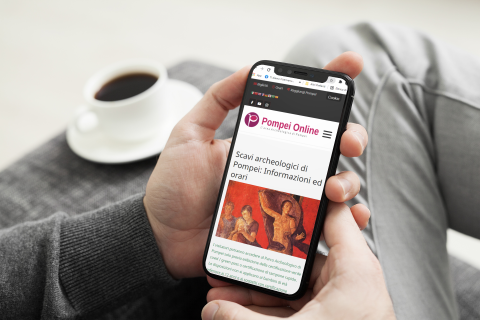“Pompeii continues to amaze with all of its discoveries, and it will continue to do so for many years yet, with twenty hectares still to be excavated. But above all, it demonstrates that valorisation can occur, and tourists can be attracted from all over the world, whilst at the same time research, education and studies are being conducted, and a young director like Zuchtriegel will develop this commitment”. Thus commented the Minister of Culture Dario Franceschini on the discovery of the chariot in the excavations of Civita Giulia. “What has been announced today is a discovery of great scientific value. A round of applause and thanks to the Archaeological Park of Pompeii, the Public Prosecutor’s Office of Torre Annunziata and to the officers of the Carabinieri Headquarters for the Protection of Cultural Heritage for the collaboration which has averted the theft and illegal sale of these extraordinary finds on the black market”.
“It is an extraordinary discovery for the advancement of our knowledge of the ancient world”, declared Massimo Osanna, outgoing Director of the Archaeological Park, “At Pompeii vehicles used for transport have been found in the past, such as that of the House of Menander, or the two chariots discovered at Villa Arianna (one of which can be admired at the new Stabian Antiquarium), but nothing like the Civita Giuliana chariot.
What we have is a ceremonial chariot, probably the Pilentum referred to by some sources, which was employed not for everyday use or for agricultural transport, but to accompany community festivities, parades and processions. This type of chariot, which has never before emerged from Italian soil, bears comparison with finds uncovered around fifteen years ago inside a burial mound in Thrace (in northern Greece, near the Bulgarian border). One of the Thracian chariots is particularly similar to ours, even if it lacks the extraordinary figurative decorations that accompany the Pompeian find.
The scenes on the medallions which embellish the rear of the chariot refer to Eros (Satyrs and nymphs), while the numerous studs feature erotes. Considering that the ancient sources allude to the use of the Piletum by priestesses and ladies, one cannot exclude the possibility that this could have been a chariot used for rituals relating to marriage, for leading the bride to her new household.
If the entire operation had not been initiated courtesy of the synergy with the Public Prosecutor’s Office of Torre Annunziata, with which a memorandum of understanding was signed in order to combat the criminal phenomena of looting archaeological sites and trafficking finds and works of art, we would have lost extraordinary testimonies which enhance our understanding of the ancient world”.
“In recent years the Public Prosecutor’s Office at the Court of Torre Annunziata has paid constant attention to the protection of the immense archaeological heritage present in our jurisdiction” – declared the Chief Prosecutor of Torre Annunziata, Nunzio Fragliasso
“The fight against the looting of archaeological sites, both inside and outside the urban area of ancient Pompeii, is certainly one of the primary objectives of the Office.
It is in this context that the memorandum signed by this Public Prosecutor’s Office in 2019 with the Archaeological Park of Pompeii is placed, which represents a ‘pilot agreement’ in the field of synergy between Institutions for safeguarding national artistic heritage.
The collaboration between the Public Prosecutor’s Office of Torre Annunziata and the Archaeological Park of Pompeii has proved itself to be a formidable instrument, not only for bringing finds of exceptional historical and artistic value to light, but also for halting the criminal actions of individuals who for years have been the protagonists in a systematic looting of the priceless archaeological heritage preserved in the vast area of the Civita Giuliana villa, which is still largely buried and to which the recent exceptional findings bear witness.
The criminal activities of which the Public Prosecutor’s Office of Torre Annunziata had been made aware, and which had to be fully confirmed - specifically the digging of a complex network of tunnels at a depth of over 5 metres, and the looting and partial destruction of illegally explored areas - required an investigative operation which could not have been carried out other than by a planned archaeological excavation, which was consequently conducted alongside the Archaeological Park of Pompeii.
The excavation operations carried out on the site by the Archaeological Park of Pompeii with the aid, for investigative purposes, of officers of the Carabinieri Headquarters for the Protection, under the constant coordination of Assistant Prosecutor Filippelli, made it possible to gather decisive and irrefutable evidence of serious and repeated incidents of the theft and trafficking of precious archaeological finds by ‘grave robbers’.
Among other things, it has been established that the very chariot which has now been unearthed had miraculously escaped the looting of grave robbers, despite being literally touched by the tunnels dug by the perpetrators at a depth of over 5 metres.
As we speak, the criminal trial against two defendants suspected of being the chief architects of the aforementioned criminal activity, whose dwelling still now stands on the site of a plundered Ancient Roman villa, is proceeding before the Court of Torre Annunziata.
The investigations have allowed us to ascertain that the network of over 80 metres of tunnels used for the systematic looting of the archaeological area originated at the property of the two defendants.
Over the coming years, the work of this Office in the protection of artistic, archaeological and cultural heritage of the area will be constant and will be given the highest priority, giving particular attention to the operation aimed at the recovery of precious archaeological finds which have been stolen and exported abroad, and their return”.


